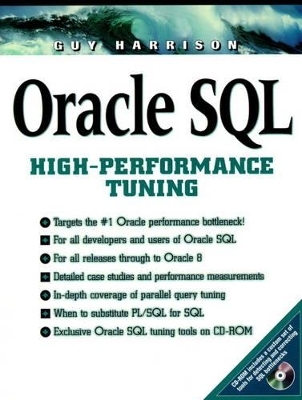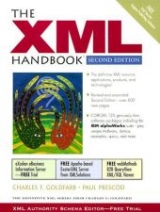
Oracle SQL High Performance Tuning (Bk/CD)
Prentice Hall
978-0-13-614231-7 (ISBN)
- Titel erscheint in neuer Auflage
- Artikel merken
61423-0 The complete developer's guide to optimizing Oracle SQL code. Optimizing SQL code is the #1 factor in improving Oracle database performance. Yet most guides to Oracle tuning virtually ignore SQL. Until now. Oracle SQL High-Performance Tuning zeroes in on SQL, showing how to achieve performance gains of 100% or more in many applications. Expert Oracle developer Guy Harrison presents a detailed overview of SQL processing, and then introduces SQL tuning guidelines that improve virtually any application. Learn how to: *Choose execution plans. *Work with joins. *Search for nulls and ranges. *Trace SQL statement execution. *Build indexes that support efficient queries. *Optimize virtually all type of SQL including: views, hierarchical queries, table scans, GROUP BY, updates, subqueries, distributed SQL, and more. As databases grow, and ad hoc queries to data warehouses increase, optimizing SQL becomes even more critical. Harrison offers practical guidance on using Oracle's parallel query facility for large-volume queries, and shows when to use Oracle's PL/SQL instead of standard SQL.The book is replete with examples, showing poorly tuned SQL, how to fix it-and specific performance measurements collected on a wide range of computer hardware, from high-end UNIX SMP hosts to 486 laptops running Personal Oracle.
The CD-ROM contains an extraordinary collection of Oracle SQL tuning tools, including: *A complete freeware Tuning Toolkit for generating SQL execution plans in a Windows environment, and for monitoring server load and efficiency. *Trial versions of the SQLab tuning environment, Precise/SQL tuning tools, and SQL Navigator development environment. *Full-function 90-day trial versions of Personal Oracle for Windows 3.1 and Windows 95. If your Oracle applications must deliver supercharged performance, you can't afford to be without Guy Harrison's Oracle SQL High-Performance Tuning.
(NOTE: Each chapter begins with an Introduction and concludes with a Chapter Summary.)
Introduction
I. THE THEORY OF SQL TUNING.
1. Introduction to SQL Tuning.
Why Tune SQL? The SQL Tuning Process.
2. Review of SQL.
History of SQL. Types of SQL Statements. Query Operations. Views. NULLs and Three-valued Logic. Transactions. Oracle Extensions to the ANSI Standard. Some Comments on the SQL Non-Procedural Approach.
3. SQL Processing.
Overview of SQL Processing. Parsing. Executing SQL. Query Optimization.
4. Principles of Indexing and Clustering.
The B*-Tree Index. Index Clusters. Hash Clusters. Bitmapped Indexes. Index Only Tables.
5. Tracing Oracle SQL.
EXPLAIN PLAN. Using SQL Trace. Using the AUTOTRACE Facility in SQL*PLUS.
II. PRACTICAL SQL TUNING
6. Tuning Table Access.
Full Table Scans and Index Lookups. Alternatives to Full Table Scans. Optimizing Index Lookups. Optimizing Table Scans. Using Hints to Influence an Access Path.
7. Optimizing Joins and Subqueries.
Choosing the Best Join Method. Choosing the Best Join Order. Optimizing Joins with Index Clusters. Outer Joins. Star Joins. Hierarchical Queries. Simple Subqueries. Subqueries Involving the IN Operator. Correlated Subqueries.
8. Optimizing Sorting and Grouping.
Sort Operations. Aggregate Operations. Set Operations. Intersect. Minus.
9. Optimizing Data Manipulation Statements.
Optimizing Individual DML Statements. Optimizing Transactions. Other DML Performance Issues. Locking.
10. Using and Tuning PL/SQL.
Performance Characteristics of PL/SQL. USING PL/SQL in Place of StandardÓ SQL. Optimizing PL/SQL.
11. Miscellaneous Topics.
Optimizing Views. Using Snapshots. Distributed SQL. Sequences. Using Decode. Data Definition Language.
12. Parallel SQL.
Understanding Parallel SQL. Parallel Query Option. Examples of Parallel Queries. Parallel DDL and DML.
13. SQL Tuning Case Studies.
Case Study 1: Using Concatenated Indexes. Case Study 2: The Rule Based Optimizer, Index Merges and Bind Variables. Case Study 3: The Slowly Degrading Query. Case Study 4: A Number Range Lookup. Case Study 5: The First Rows Approach.
III. BEYOND SQL TUNING.
14. Data Model and Application Design.
Building Tuning into the Design Process. Designing an Efficient Physical Data Model. Application Design.
15. Building A High-Performance Oracle Database Server.
A Review of the Oracle Architecture. Sizing the Host Computer. Building the Oracle Database.
16. Tuning the Database Server.
Evaluating Operating System Performance. Recognizing Oracle Database Bottlenecks.
Appendix A : Reference.
Appendix B: Glossary.
Appendix C: Configuring Development Tools.
Appendix D: Oracle Server Configuration.
Appendix E: Differences Between Oracle Versions.
Appendix F: Bibliography and Resources.
Appendix G: Contents of the CD-ROM.
Index.
| Erscheint lt. Verlag | 27.5.1997 |
|---|---|
| Verlagsort | Upper Saddle River |
| Sprache | englisch |
| Maße | 180 x 235 mm |
| Gewicht | 993 g |
| Themenwelt | Informatik ► Datenbanken ► Oracle |
| Mathematik / Informatik ► Informatik ► Software Entwicklung | |
| ISBN-10 | 0-13-614231-1 / 0136142311 |
| ISBN-13 | 978-0-13-614231-7 / 9780136142317 |
| Zustand | Neuware |
| Haben Sie eine Frage zum Produkt? |
